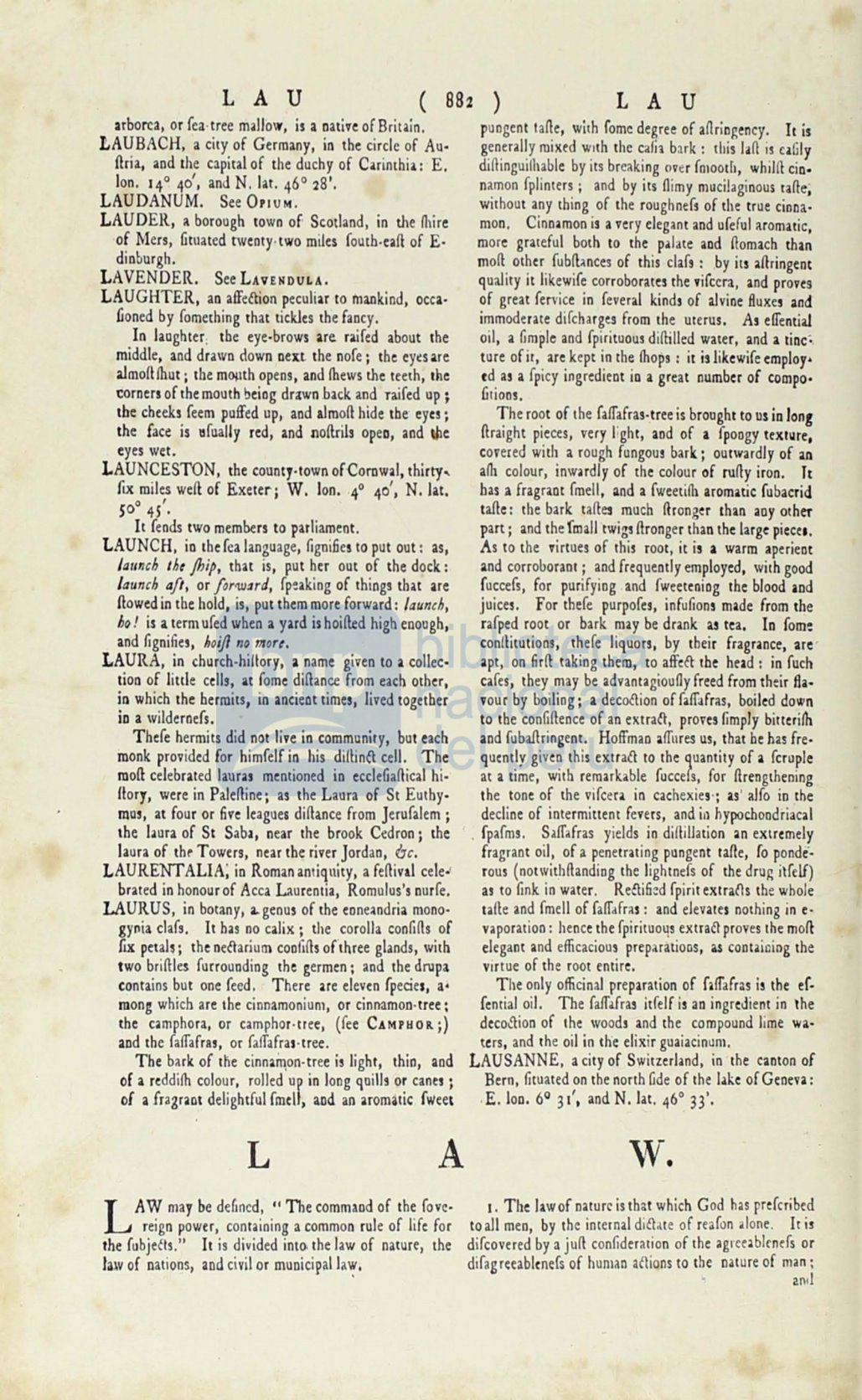

L A U
arborca, or [ea·tree mallolJ, is a oative ofBritain.
LAUBACH, a city of Germany, iD Ihe cirele of Au–
firia, aod the capitalof the duchy of Carinthia :
E.
Ion.
14°
40"
and N. lat.
46°
28'.
LAUDANUM. See OPIUM .
LAUDER, a borough town of Scodand, in the nlire
of Mm, Gtuated rweoty·two miles [outb·eafi of E·
dioburgh.
LAVENDER. See LAVENOULA.
LAUGHTER, ao affeaion peculiar to inaokiod, occa–
fioned by fomething that lickles thefaocy.
In laoghter: tbe eye-brows are raifed about the
middle, aod drawo down oeXL Ihe nofe; the eyesare
a1moUlhut; the mo¡lth opens, and Ihews rhe teeth, the
corners of the mouth beiog drawn hack and nifed up ;
Ibe cheeks [eem puffed up, aod atmofi hide Ibe' eyes;
Ihe race is afually red, and noílrils opeo, and lJ¡e
eyes IVet.
LAUNCESTON, the county·town of-Cornwal,lhirty_
fIX
miles wefi of Exmr'j
W.
loo.
'4° 40"
N. lat.
50°
4S'·
h
feods IWO members to parliameot.
LAUNCH, io tbe fca language, figniSes to put out : as,
latlnch Ihe
/hip,
Ihat is, put her out of Ihe dock:
launch a/I,
or
/crw:Jrd,
fpeaking of Ihings that are
fiowed in the hold, is, put them more forward:
launch,
he!
is a lerOl uCed when a yard is hoified high eoough,
and fignifies,
hoij/ no more.
LAURA, in church-hillory, a name given to a eollec–
tioo of little cells, at Come difiance from each other,
in which the berroits, in aneient limes, lived togetber
io a wildernefs.
TheCe hermits did not live in community, but eaeh
monk provided for himCelf in his dilHoa cell. The
mofi eelebrated lauras menlÍoned in eceleuafiieal hi–
Hory, were in Palefiine; as the Laura of St Euthy–
mas, at four or 6ve leagues difiance from JeruCalemj
Ihe laura of St Saba, near the brook Cedron; the
laura of
Ih~
Towers, near the river Jordan,
&c.
LAURENTALIA; in Romanantiquity, a fefiival cele-'
brated in honour of Acca Laurentia, Romulas's nurCe.
LAURUS, in botany,
a.
genus of the
eone~ndria
mono–
gyoia claCs.
lt
has no calix; Ihe eorolla confins of
fIX
petals; the neélarium coofifis oF'three glands, with
two brifiles Currouoding the germen; and the drupa
eontains bu! one feed. There are eleven {pecies, al
mong which are the cinnamoniuOl, or cinnamon·tree;
the camphora, or camphor.tree, (Cee CAMPUOR
¡)
¡od the falfafras, or CalfafraHree.
The bark of tlie cinnam,on.tree is light. thin, and
of a reddilh eolour, rolled
Uf
in long qoills or canes
i
of a ú azraot delightful Cmel , aod an aromatie {\'Ieet
L
A
L
AW
may be denncd, "Theeommaod of the Cove–
reign power, contaioing a common rule of tife for
Ihe fubje/Is."
It
is divided inlOo the law of nature, the
¡_IV
of oations, aod civil or
muoicipalla~,
L A U
pungent tane, with fome degree of anriogency. It is
generally mixed wlth the cafil bark: this lan is caGly
dininguinlable by its brcaking om COIOOtr" whilfi cio–
namon Cplinters; and by its flimy mueilaginous ta(le;
without any thing of the roughneCs of the true ciona–
mono Cino.mon is avery elegant aod ufeful aromatie,
more grateful both to the paJate aod (lomach rhan
moa other {ubfiances of this claCs : .by ils afiringent
quality it likewiCe corroborates the viCcera, and proves
of great {ervice in feveral kinds of alvine Huxes and
immoderate difeharges from the merus. As eíl'entia!
oil, a fimplo and fpirituous difiilled water, and a
tioc~.
ture ofit, are kcpt in the Ihops : it is likewife employ'
ed as a {picy ingredieot io a great number of compo–
filÍoos.
The root of the falfafras·tree is brought
10
us io long
firaight pieces, very Fght, aod of a fpoogy texNre,
covered with a rough fungous bark; outwardly of an
anl colour, inwardly of the colour of ru(ly iron.
TI
has a fragraot Cmell, and a CWeetinl aromatie Cubacrid
talle: the bark !afies mueh firongcr than aoy other
part
j and the fmall twigs fironger thao the large piem.
As to the ,irtues of this root, it is a warm aperieo!
and corroboraot j aod frequeotly employed, with good
fucceCs, for purifyiog and {weeteniog the blood .od
juices. For theCe purpofes, infufions made from Ihe
raCped root or bark may be drank
as
tea.
lo
fome
conllitutioos, thefe liquon, by tbeir fragrance, are
'pt, on 6rfi takiog thero, to alt'ca tbe he.d: in Cuch
caCes,
they may be advantagiouny freed from their Ila–
vour by boiliog j a deeo(tion of f.Ifafras, boiled do.,n
to tbe conufience of an extraa, proves fimply bitterifh
and fuballringent. HofFmao .lfmes us, that be has fre–
quently given this extraa to the quantity of a Ccruple
at a time, wilb remarkable fucceCs, for nrengthening
the tone of the vifcera in cachexies';
as'
alfo in the
decline of interminent fevers, and i'l hypochoodriacal
. fpaCms. Salfafras yields in diflillation 'n eXlremely
fragrant oil, of a penetratiog pungent talle, Co ponde'–
rous (notwithnandiog the lightnefs of the
dru~
ilfelf)
as to fink in water.
Reélifi~d
fpirit extrafls the whoJe
tafle and fmell of Cafr.fras: and e1evales nothing in
e·
vaporation: henee the fpirituoqs extrae proves the mofi
elegant and eRicacious preparatioos, as cootaioing the
vinue of Ihe root entire.
The only oRicinal preparation of falfafras is the eC–
feotÍal oi!. The Cal!'.fras ¡tfelf is an ingrcdient in lhe
decoétion of the woods and the compound lime wa–
ters, and the oil in th'e elixir guaiacinum.
LAUSANNE, a city of Switzerland, in the canton of
Bern, utuated on the north Gde of the lake of Geneva:
.E.loo.
6° 31'.
and N.lat.
46° 33'.
w.
l .
The lawof nature is that which God has preCcribed
to all men, by the internal diam of reafon ,Ione.
lt
is
diCcovered by
a
jufi confideration of the
agrmblrn~Cs
or
diCagreeabl~nefs
of human aflions to the Dature of Olan;
•
2nd
















